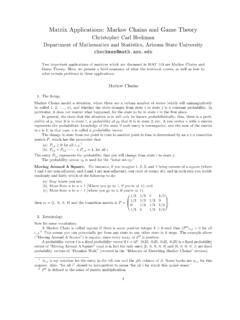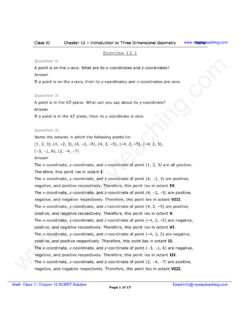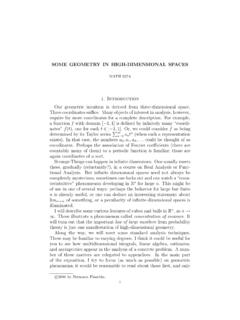Transcription of INTRODUCTION TO 3-MANIFOLDS - Arizona State University
1 INTRODUCTION TO 3-MANIFOLDSNIK AKSAMITAs we know, a topological n-manifoldXis a Hausdorff space such that every point con-tained in it has a neighborhood (is contained in an open set) homeomorphic to an n- dimensional open ball. We will be focusing on 3-MANIFOLDS much the same way we lookedat 2- manifolds (surfaces).A basic example of a 3-Manifold:R3is a 3-manifold because every point inR3is containedin an open ball study of 3-MANIFOLDS will benefit greatly by making sure we have a strong standing insurfaces. All surfaces admit one of three geometries or geometrics StructuresA geometric structure is defined as a complete and locally homogenous Riemannian man-ifold. That is, a manifold with a metric defined locally (in the target space) that can beintegrated to find lengths of line with minimum length, also known as a distance-minimizing path, between twopoints is called a three geometries that model all surfaces are Euclidean (flat geometry), spherical,and hyperbolic geometry.
2 These three geometries act as the universal covers of all and Hyperbolic geometries are infinitesimally Euclidean. That is, in arbitrarilysmall neighborhoods, these geometries behave like Euclidean geometry. However, on alarger scale these three geometries can be differentiated by several unique attributes. Wewill look at geometry follows Euclids fifth postulate: given any line and a disjoint point, thereexists exactly one line containing our point that does not intersect our given and Spherical geometry do not. In Hyperbolic geometry there exist at leasttwo lines (defined later) disjoint to our given line and containing our point. In Sphericalgeometry, all lines AKSAMITAs well, consider a geodesic triangle, three points connected by geodesics, in the threegeometries. In Euclidean geometry the sum of angles inside a geodesic triangle, , is alwaysequal to.
3 In hyperbolic geometry, 0< < . In spherical geometry, > .Figure to R, Triangles in Euclidean, Hyperbolic, and Spherical Hyperbolic majority of 3-MANIFOLDS admit a hyperbolic struc-ture [Thurston], so we shall focus primarily on the hyperbolic geometry, starting withthe hyperbolic plane,H. There are several model spaces ofH. By that we mean a wayof displaying geometric shapes in an underlying space. We shall focus on the upper-halfplane and the disc model, both of which have the complex plane as the underlying space, upper half plane is defined as:H={z C,Im(z)>0}with the metricds=|dz|Im(z)Figure and Upper Half Plane Model ofH(Silvio Levy)There exist two types of lines in the upper half plane. If points x, y have the same realcomponent inC, the line connecting them is perpendicular to real line inC. If x and y doINTRODUCTION TO 3-MANIFOLDS3not have the same real component, then a line connecting them is defined as a Euclideancircle centered on the real disk model is defined as:H={z Csuch that|z|<1}With the metricds=2|dz|1 |z|2 Most lines in the Poincare disk model are arcs of circles that intersect the boundaryS1orthogonally.
4 There also exist Euclidean straight lines that connect two points oppositeeach other across the center. Both types are displayed in Figure 2 and Figure any n- dimensional hyperbolic space. There exists exactly one geodesic connecting twopoints. In fact, the uniqueness of lines in the hyperbolic plane is discussed in [Anderson]. Aswell, in both the hyperbolic plane and its three dimensional analog, as a line approachesthe boundary, whether it be the bottom of an upper half model, or the boundary of aball/disk model, the metrics are defined such that the length of the line increases and is ofinfinite length if it intersects the boundary. As well, in any dimension of hyperbolic space,angles between lines (and planes) approach zero as the length of sides image of two Octagons in the Hyperbolic Disk Modeladapted from [Lackenby]In Figure 3, we can see this as the length of our sides get larger.
5 If two lines intersect at theboundary, since they both intersect the boundary orthogonally, the angle between themwill be zero. Since Hyperbolic geometry is infinitesimally Euclidean, by an application ofthe intermediate value theorem, we can make our angle anything we desire between its4 NIK AKSAMITE uclidean angle and zero. It is worth noting the opposite is true in n- dimensional sphericalgeometries. As the length of sides of a polygon increase towards their boundary, the anglebetween them increases towards 180 the Hyperbolic Plane, there exist several modelspaces for Hyperbolic 3-Space. The two we will focus on are the analogs to our 2- dimensional examples. The left figure below is an the open ball model with examples ofplanes. The right diagram is the Upper Half Space model with examples of Ball and Upper Half Space Model (Silvio Levy)The Upper Half Space is defined asR3such that the z-coordinate is greater than exist in the Upper Half Space in two forms.
6 They are either planes that runperpendicular toR2, or as hemispheres that metric on the Upper Half Space isds=|~dx|tThe open ball model can be thought of asR2 , or simply as an open unit 3-ball. Planesin the open ball model exists as either Euclidean planes that pass through the center of theball (whose intersection with the boundaryS2is a great circle), or as a hemisphere whoseintersection with the boundaryS2is orthogonal. More specifically they are fixed point setsof involutions (isometries of order 2).The metric on the open ball model isds=2|~dx|1 |~x| that we are working in the 3-space, lets define one more 3-manifold that should bereadily available for our understanding: INTRODUCTION TO 3-MANIFOLDS5 The 3-torus is a 3-manifold constructed from a cube inR3. Let each face be identifiedwith its opposite face by a translation (without twisting). You can imagine this as a directextension from the 2-torus we are comfortable with.
7 If you were to sit inside of a 3-torusand look straight you would see infinitely many images of yourself. Unlike in a hall ofmirrors though, you would see images of the back of your head. In a 3-Torus, you wouldnot only see infinite images of yourself from behind in front of you, but if you were tolook up you would see images of you from below repeating off into space. If you were tolook to your left you would see the right side of your body, with infinite repetitions behindgradually getting 3-torus is constructed fromE2because all the faces of a cube can be identified withoutany overlap of angles. By this we mean the dihedral angles of the cube are 90 degrees. Ifwe take a point on an edge of the cube, a neighborhood of our point is a 90 degree wedgeof a 3-ball. After gluing the face containing one of the edges of our 90 degree wedge withit s opposite face, we now have a hemisphere as a neighborhood.
8 One more identificationof faces creates a 3-balls neighborhood. If you think of a vertex on the corner of thecube, a neighborhood about that point is one quarter of a sphere with three planar we glue these faces with their opposites we can realize the neighborhood is actuallya we are to think of higher dimensional polyhedra, problems arise when gluing regular dodecahedron in Euclidean space has dihedral angles of approximately If we take a point on an edge of a pentagon, the open neighborhood of that pointis a little less than a one third wedge of a 3-ball, with two planar faces. If we are to identifyopposite faces with minimal twisting, there is no way to create a complete 3-ball about apoint on an edge in Euclidean geometry. We will either under shoot the dihedral sum of360 degrees, or go way we can look at other geometries. We could put our dodecahedron in a Sphericalgeometric structure and make our dihedral angles equal 120 degrees by increasing it s a 1/10 clockwise twist of opposite faces while gluing, this creates a 3-manifold calledthe Poincare dodecahedral well, in hyperbolic geometry we can make the inside angles of polygons as small aswe want by making the edges longer.
9 Using this method and a system of twists we canconstruct something called the Seifert-Weber space in Hyperbolic Space. This happens tobe a Hyperbolic :A Hyperbolic 3-Manifold is a quotient manifoldH3/ , where is a discretegroup of orientation preserving isometries isometry in general is a distance preserving homeomorphism on a space. That is, ahomeof: (X,dX) (f(X),df(X)) such thatdX(x,y) =df(X)(f(x),f(y)) for every x andy in AKSAMITThis definition of Hyperbolic 3-manifold follows the same idea as the universal coveringof the 2-Torus by the Euclidean plane. The 2-torus is a Euclidean 2-manifold because itis the quotient manifold ofE2by the isometry group =< t1,t2>, where< t1,t2>isthe normal subgroup of translations in the x and y directions. This was essentially thesame as taking a grid of squares and identifying the edges of each square in theaba 1b of Hyperbolic 3-ManifoldsFigure Space (Silvio Levy) construct the Seifert-Weber Dodecahedral Space, take adodecahedron and identify opposite faces with a 3/10 clockwise observing our quotient maps combinatorially, we see that the edges are connected in6 groups of 5.
10 Thinking back to the problem mentioned above, we know the dihedralangles are of approximately degrees in Euclidean space. Therefore to make these 5wedges line up without overlap we need smaller dihedral angles. From earlier we know bythe intermediate value theorem we can place our dodecahedron in Hyperbolic Space andlengthen edges until we get a satisfactory angle. Since edges are glued in groups of five, adihedral angle 72 degrees would add up to 360 degrees perfectly. This is easiest to see inthe open ball model above we must check to see if this is actually a 3-manifold after is easy to see that point in the middle of one of our pentagon faces has a 3-ball neigh-borhood. Before gluing, the neighborhood is an open hemisphere, and after identificationwith the opposite face, we complete our 3-ball. (Think of a point sandwiched between twosolid walls.) INTRODUCTION TO 3-MANIFOLDS7 Points on the edge of a pentagon are a little more difficult to see.

















